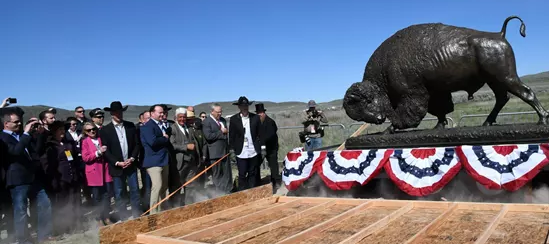To tell the story described below, the Hal and Naomi Tate Foundation commissioned and donated the artwork “Distant Thunder” by sculptor Michael Coleman, to the Golden Spike National Historical Park. This was the unveiling ceremony, May 10th, 2019, as part of 150th anniversary recognition of the completion of the transcontinental railroad in the Utah Territory on May 10, 1869. Courtesy of the NPS.
Writing about the American bison, Douglas Branch published in 1929 the book The Hunting of the Buffalo (republished 1963 and again in 1997, the latter including a very worthwhile forward by Andrew C. Isenberg). In his book Branch—a young scholar far removed from the world of the American West—wrote of the near extinction of this keystone species of the Plains ecoregion; an animal that before European settlement (before 16th c.) numbered from thirty to sixty million.
As one of North America’s largest animals, the bison stands nearly ten feet at its hump and can weigh up to 2,800 pounds. Besides its place in its ecosystem, it also played a “keystone” role in the hunting economy, food and lifeways of the North American Plains Indians, including among other tribes, the Kohogue (Green River Shoshone), Chahiksichahiks (Pawnee), Banakwut (Bannock), Tsetsehestahese, Oo’heuhpa and Tukaduka (Shoshone), S’o’laeo’o (Cheyenne) and Umonhom (Omaha).
Using letters, diaries and Native and non-Native oral accounts, Branch tells, for his time, a forward looking story, of a vibrant world before and the animal’s near extermination, as well as the near destruction of the Plains Indian; all facilitated by the coming of the railroads. Branch writes:
“The wild life of the Buffalo was cut short with the penstroke when in 1862 a bill for the construction of a railroad from the western border of Iowa to San Francisco [initially just to Sacramento] received the president’s signature [Abraham Lincoln].” [p. 127]
“…the cleaning of the range by the twin steel bands meant that the bison, the bulls, cows and calves would be shot down; and the Indians would not be allowed to remain a hunter, or even a native; And that the “jackalls [wolves, foxes and coyotes]” would be poisoned and their skins redeem for bounties.”
“In 1865 the actual building of the Union Pacific Railroad was begun. With its completion the buffaloes in the United States were divided into two great herds that never joined again: a northern herd of about 1 ½ M, and the southern herd of nearly 5M Buffalo. The northern herd ranged from Powder River Country and into the British possessions. In the Southwest buffaloes were abundant in western Texas; but the favorite feeding grounds of the southern herd was the section of the plains above the Republican River, between the Arkansas and the South Platte.”
“Both herds retreated from the roadway of the Union Pacific, leaving a strip of fifty miles and more barren of any great wild life.” [p. 128]
“The year of the golden spike was driven that completed the lane at the trans-Pacific railway, the Kansas Pacific Railroad was building across Kansas, towards Denver; and the Atkinson, Topeka, and Santa Fe was throwing its rails across the wagon ruts of the Santa Fe trail. The southern herd was hacked by the advancing line of travel, and for seekers of profit or pleasure the way was open into the heart of the Buffalo country.” [p. 128].
Do you want to experience more regarding this history? Come and be a part of the “Railroads in Native America” Gathering, May 19-21, 2022 at the Ogden Union Station. Attendance is free, either in-person or by attending remotely; however, registration is requested, click here.
To learn more about the historical and current bison herds of North America, read or see:
- From the National Park Service: Golden Spike National Historical Park (Utah): Where the Buffalo Roamed
- From the Smithsonian Magazine: Where the Buffalo No Longer Roamed: The Transcontinental Railroad connected East and West—and accelerated the destruction of what had been in the center of North America
- From Wired: When the Bison Come Back, Will the Ecosystem Follow? An effort to bring wild buffalo to the Great Plains aims to restore one of the world’s most endangered landscapes and increase climate resilience.
- Regarding the general location of the Native American Tribes in the Midwest, see Smithsonian Museum of American History: https://americanhistory.si.edu/buffalo/map.html

